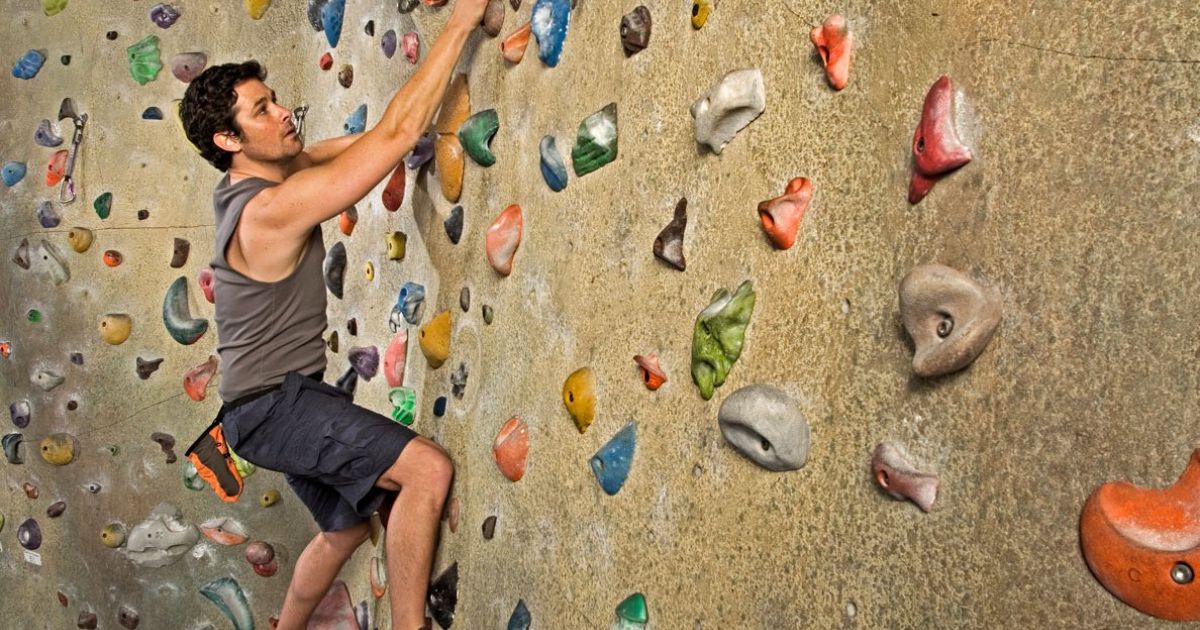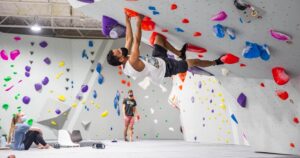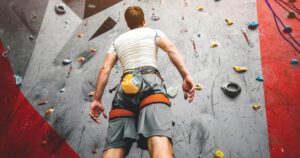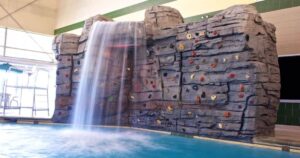In the thrilling world of indoor rock climbing, adventure seekers embrace the vertical challenge, defying gravity and pushing their physical and mental limits. However, before embarking on this exhilarating journey, it is essential to address the question: is indoor rock climbing safe? This article explores the risks and safety measures associated with this popular sport. By delving into the importance of proper equipment, training, and injury prevention, we aim to provide a comprehensive guide for those seeking a safe and enjoyable indoor climbing experience.
Key Takeaways
- Indoor rock climbing provides numerous benefits such as a full-body workout, improved strength and flexibility, increased cardiovascular fitness, and positive mental well-being.
- While there are potential climbing injuries, such as sprains, strains, and finger/hand injuries, the risk can be minimized through proper warm-up, technique, hand care, and the use of appropriate climbing gear.
- Indoor climbing facilities implement various safety measures, including well-maintained equipment, experienced staff, mandatory safety orientations, and the provision of crash pads and harnesses.
- Proper supervision and training are crucial in ensuring the safety of climbers, reducing the likelihood of accidents, and creating a secure and enjoyable environment for climbers of all skill levels.
The Growing Popularity of Indoor Rock Climbing
Indoor rock climbing has experienced a significant rise in popularity in recent years. This surge can be attributed to several factors, including the numerous health benefits it offers and its positive impact on mental well-being.
Firstly, indoor rock climbing is a full-body workout that engages multiple muscle groups. It helps to improve strength, endurance, and flexibility. Climbers often experience increased cardiovascular fitness and improved body composition. Additionally, it is a low-impact activity, reducing the risk of injury compared to other high-impact exercises.
Moreover, indoor climbing has been found to have a positive impact on mental well-being. The focus and concentration required during climbing can help to alleviate stress and anxiety. It also promotes problem-solving skills and boosts self-confidence as climbers conquer challenging routes. The supportive community and sense of belonging that indoor climbing provides can further contribute to improved mental health.
Understanding the Risks Involved
Understanding the risks involved in indoor rock climbing is essential for climbers of all skill levels. While it can be a thrilling and enjoyable activity, there are potential climbing injuries that climbers need to be aware of, such as strains, sprains, and falls. To mitigate these risks, indoor climbing facilities implement safety measures such as the use of crash pads, proper equipment checks, and trained staff to ensure a safe climbing environment.
Potential Climbing Injuries
When engaging in indoor rock climbing, climbers should be aware of the potential injuries associated with this activity. Indoor climbing, though safer than outdoor climbing, still carries some risks. Here are three potential climbing injuries that climbers should be mindful of:
- Sprains and strains: Climbing involves repetitive and dynamic movements that can put a strain on the muscles and joints, leading to sprains or strains. Warming up before climbing can help prevent these injuries by increasing blood flow and flexibility.
- Finger and hand injuries: Climbing puts a significant amount of stress on the fingers and hands. Overuse or improper technique can lead to conditions like pulley strains, tendonitis, or even fractures. Proper hand care, such as taping and regular rest, can help prevent these injuries.
- Falling accidents: Although rare, falling accidents can occur during indoor climbing. It is important to follow proper safety protocols, such as using a harness, checking equipment, and having a spotter when necessary.
Understanding these potential injuries and taking necessary precautions can help climbers enjoy indoor rock climbing safely.
Safety Measures Implemented
To ensure the safety of climbers, it is essential to implement effective safety measures while acknowledging the inherent risks involved in indoor rock climbing. Indoor climbing facilities prioritize the well-being of their participants by implementing various safety measures. These measures include:
| Safety Measures | Description |
|---|---|
| Well-maintained equipment | Regularly inspected and replaced climbing gear and ropes to ensure their reliability and functionality. |
| Experienced staff | Employing knowledgeable and trained staff members who can offer guidance, supervision, and assistance to climbers. |
| Safety orientations | Conducting mandatory safety orientations for all participants to familiarize them with climbing techniques and safety protocols. |
| Crash pads and harnesses | Providing crash pads and harnesses to minimize the risk of injury in case of a fall. |
| Regular route setting | Routinely changing the climbing routes and challenges to prevent complacency and keep climbers engaged. |
Indoor rock climbing offers numerous benefits, including improved strength, flexibility, and problem-solving skills. However, proper supervision is crucial to ensure the safety of climbers, especially beginners. Trained staff members are essential to guide climbers, monitor their progress, and intervene if necessary, reducing the likelihood of accidents. By implementing these safety measures and prioritizing supervision, indoor climbing facilities strive to create a secure and enjoyable environment for climbers of all skill levels.
Safety Measures in Indoor Climbing Facilities
When it comes to safety measures in indoor climbing facilities, there are two key aspects that need to be addressed: harnessing and belaying techniques, and equipment inspection and maintenance. Proper harnessing and belaying techniques are essential for ensuring the safety of climbers, as they provide the necessary support and control during climbs. Additionally, regular inspection and maintenance of climbing equipment is crucial to identify any potential risks or defects that could compromise the safety of climbers. These measures, when followed diligently, contribute to creating a safe and secure environment for indoor rock climbing.
Harnessing and Belaying Techniques
Indoor rock climbing facilities employ harnessing and belaying techniques regularly to ensure the safety of climbers. These techniques are crucial in preventing accidents and providing climbers with a secure climbing experience. Here are three key aspects of harnessing and belaying safety:
- Harnessing Techniques: Climbers are fitted with a harness that is designed to distribute their weight evenly and comfortably. The harness is made of strong, durable materials and is adjustable to fit different body sizes. Additionally, climbers are taught how to properly wear and adjust their harnesses to ensure a snug fit, reducing the risk of injury during a fall.
- Belaying Safety: Belaying is the act of controlling the rope for a climber. This technique involves a belayer who manages the rope, ensuring it is properly secured and providing a controlled descent for the climber. Belaying devices, such as friction devices or mechanical belay systems, are used to enhance safety and reduce the risk of falls. Belaying techniques are taught and practiced extensively to ensure proficiency and minimize accidents.
- Safety Checks: Before every climb, climbers and belayers perform safety checks to ensure that all gear is properly worn, adjusted, and connected. These checks involve inspecting harnesses, knots, carabiners, and other equipment to ensure that everything is in good working order. This thorough examination helps identify any potential issues or risks, allowing for timely corrections and a safer climbing experience.
Equipment Inspection and Maintenance
Facilities for indoor rock climbing prioritize safety through rigorous equipment inspection and maintenance. Regular equipment inspection ensures that all climbing gear, including harnesses, ropes, carabiners, and belay devices, are in proper working condition. This helps to prevent accidents and minimize risks during climbing sessions. In addition to inspections, maintenance procedures are followed to ensure the longevity and effectiveness of the equipment.
Safety guidelines and protocols are established to guide staff members in conducting thorough inspections and maintenance tasks. These protocols include checking for wear and tear, testing the strength and functionality of equipment, and replacing any damaged or worn-out gear. By adhering to these safety measures, indoor climbing facilities create a secure and reliable environment for climbers, giving them the confidence to pursue their passion without compromising their safety.
| Equipment Inspection and Maintenance | |
|---|---|
| Regular inspection | Ensures gear is in working condition |
| Maintenance procedures | Extend equipment longevity |
| Safety guidelines | Guide staff in inspections and maintenance |
| Wear and tear check | Identifies damaged gear |
| Replacement of damaged gear | Ensures climbers’ safety |
Importance of Proper Equipment and Gear
Proper equipment and gear are essential for ensuring the safety of indoor rock climbers. In order to maintain the safety standards, it is crucial to regularly inspect and maintain the gear. This includes checking the condition of the ropes, harnesses, carabiners, and helmets, and ensuring they are in good working condition. Here are three key reasons why proper equipment and gear are important in indoor rock climbing:
- Safety: Proper gear maintenance ensures that the equipment is functioning correctly and reduces the risk of accidents or equipment failure during climbing sessions.
- Protection: Wearing appropriate footwear is crucial for indoor rock climbing. Climbing shoes provide better grip and support, reducing the chances of slipping or falling.
- Comfort: Proper gear, such as well-fitted harnesses and helmets, enhances comfort during climbing, allowing climbers to focus on their technique and enjoyment.
As climbers understand the importance of using the right equipment and gear, it becomes evident that training and certification for indoor climbing are equally important for a safe and enjoyable climbing experience.
Training and Certification for Indoor Climbing
To ensure the safety and competence of indoor rock climbers, it is imperative to undergo proper training and obtain certification. Training benefits individuals by equipping them with the necessary skills and knowledge to navigate the challenges of indoor climbing. It includes learning techniques such as belaying, rope management, and proper body positioning. Additionally, training covers safety protocols, risk management, and emergency procedures.
By undergoing training, climbers gain confidence in their abilities and can make informed decisions while on the wall. The certification process involves demonstrating proficiency in these skills through practical and written assessments. Certification not only validates a climber’s competence but also ensures consistency and adherence to industry standards. It provides climbers with a sense of achievement and recognition, fostering a sense of belonging within the climbing community.
Common Injuries and How to Prevent Them
Indoor rock climbing, despite proper training and certification, poses inherent risks that can lead to common injuries if precautions are not taken. To prevent climbing injuries and ensure a safe climbing experience, climbers should adhere to the following safety precautions during their indoor climbing sessions:
- Warm-up and Stretching: Before starting any climbing activity, it is crucial to warm up your body and stretch your muscles to prevent strains or pulls.
- Proper Equipment: Always use proper climbing gear, including a helmet, harness, and appropriate climbing shoes, to ensure your safety during the climb.
- Spotter or Belayer: Whether climbing alone or with a partner, having a spotter or belayer is essential. They can provide support, catch falls, and minimize the risk of injury.
Tips for a Safe and Enjoyable Indoor Climbing Experience
To ensure a safe and enjoyable indoor climbing experience, it is important to take certain measures and be mindful of key factors. First and foremost, mastering proper climbing techniques is essential. This includes learning how to balance your body weight, maintain a strong grip, and utilize efficient movements. Familiarize yourself with different climbing holds and practice various climbing routes to improve your skills and confidence.
Another crucial aspect is finding the right climbing shoes. Proper footwear provides the necessary grip and support for successful climbing. Look for shoes that fit snugly, but not too tight, to ensure comfort and stability. The type of climbing you plan to do, whether bouldering or rope climbing, will also influence your shoe selection.
Frequently Asked Questions
What Are the Benefits of Indoor Rock Climbing Compared to Outdoor Rock Climbing?
Indoor rock climbing offers numerous benefits compared to outdoor climbing. It provides a controlled environment for developing physical fitness, improving technique, and promoting mental health. Additionally, the social aspect of indoor climbing communities fosters a sense of belonging and camaraderie.
Are There Age Restrictions for Indoor Rock Climbing?
Age restrictions for indoor rock climbing vary depending on the facility and the specific type of climbing being offered. Some facilities may have age limits for certain areas or activities, while others may require parental consent or supervision for younger participants.
Can Beginners With No Prior Climbing Experience Try Indoor Rock Climbing?
Beginners with no prior climbing experience can try indoor rock climbing, but it is important to take certain safety precautions. Indoor climbing facilities often provide introductory classes to teach beginners the necessary skills and techniques. It is important to understand that there is a learning curve in indoor rock climbing, and beginners should start with easier routes and gradually progress to more challenging ones to avoid injury.
What Are the Typical Costs Associated With Indoor Rock Climbing?
Typical costs associated with indoor rock climbing include membership fees, day passes, and equipment rentals. Safety precautions are paramount, with indoor climbing equipment designed to minimize risk. Indoor climbing techniques can be learned through instruction, and some facilities offer competitions for climbers to showcase their skills.
How Can I Find a Reputable Indoor Climbing Facility Near Me?
When searching for a reputable indoor climbing facility near you, it is important to consider safety measures. Look for facilities that prioritize safety through regular equipment inspections, trained staff, and adherence to industry standards.
Conclusion
In conclusion, indoor rock climbing can be a thrilling and exhilarating activity, but it is not without its risks. By understanding and following the safety measures in indoor climbing facilities, using proper equipment and gear, and receiving proper training and certification, climbers can significantly reduce the chances of injuries. However, it is important to remain cautious and vigilant to prevent common injuries. With the right precautions and preparation, indoor rock climbing can be a safe and enjoyable experience, allowing climbers to reach new heights.










